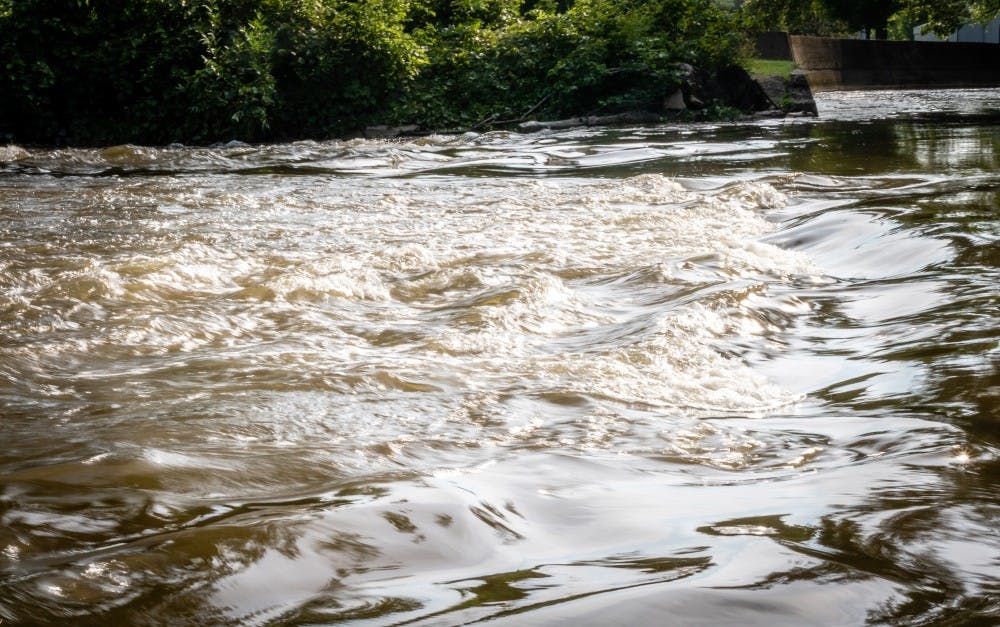Road salt detrimental to plants, animals found in surrounding bodies of water
The beginning of the 2019 year brought Michigan some of the coldest temperatures its residents have seen in years, bringing sheets of ice on the sidewalks and multiple heavy snow storms.
To respond to all the snow and ice, maintenance crews used more salt on the sidewalks and roads. Central Michigan University used 1,000 tons of salt across campus this year, said Jonathan Webb, the associate president of facilities management.
Now, that all the snow has melted, all the salt that was put on the ground went with it. Where does all the salty excess water go?
The salt seeps into the ground and washes into lakes and rivers. Specifically, most of the salt in Mount Pleasant will end up in the Chippewa River. Experts say all the salt can have negative impacts on the quality of the water, which in turn hurts many plants and animals in the ecosystem.
Standards for salt in freshwater
Chloride found in salt can be toxic to plants and animals, said earth and atmospheric science faculty Nicole West. For example, if someone over-salts the sidewalk next to their lawn, the grass will turn brown and die.
That's why there are standards for the amount of chloride ions in drinking water and different freshwater systems, West said. Michigan has relatively high water-quality standards compared to the national standards.
Michigan's standard for maximum salt levels is 50 milligrams per liter. The Environmental Protection Agency has standards that set the maximum salt levels in freshwater systems at 230 milligrams per liter. The national standard would be equivalent to about one teaspoon of salt in five gallons of water.
“If you think about the 10- or 15-pound bags of salt that people use just around their house over the wintertime, that would require 10,000 gallons of water to dilute that salt to the federal regulatory standard,” West said.
Michigan has its standards set so high, West explained, because all the waterways in Michigan, like the Chippewa River, will eventually drain into the Great Lakes, where chloride ions will accumulate.
“(Chloride) doesn’t degrade. It just stays,” West said. “All the chloride that you put into a reservoir or a lake or the water will remain there. It doesn’t break down.”
That means that salt will wash into a lake, sink to the bottom because of its density and stay there. Each winter, a new layer of salt makes its way to the bottom of Michigan's freshwater systems.
The Saginaw Chippewa Indian Tribe measures the water quality of the Chippewa River. The tribe uses specific conductivity as a measure for salt concentration. The EPA's reference level for specific conductivity is 500 microsiemens per centimeter, said Kellie Henige, the tribe's water quality specialist.
As of April measurements, most of the Chippewa River is within the recommended guidelines, but the section near highway M-20 and South Meridian Road measured at 625.9 microsiemens per second, Henige reported.
High salt concentrations affect life in the lakes
Eventually, enough chloride will build up in these ecosystems that it will affect the organisms that live there.
For example, Third Sister Lake near Ann Arbor has built up so much salt from its surrounding roads that it has formed a layer on the bottom of the lake and organisms can no longer live there, said biology faculty Hunter Carrick.
Carrick explained that because water is so dense with chloride ions at the bottom of the lake, the water at the top of the lake cannot mix with the bottom water as most bodies of water do in winter. This makes the bottom water uninhabitable.
The reason salt is so harmful to these freshwater organisms is because their bodies are not made to withstand high salt concentrations. Therefore, different types of organisms are found in each environment. For example, a high number of largemouth bass can be found in a freshwater lake, while Atlantic cod would be in the ocean.
Carrick has also studied other streams and lakes throughout Michigan. He has found that lakes with a lot of salt build-up have started to shift in the type of algae that grows in them.
While the lakes used to inhabit algae typically found in freshwater, it now contains algae that could grow in coastal systems.
“They’re things that are what we would say would be tolerant to changing salinity because depending upon when the runoff happens, they may get a slug of salt and have to be able to survive that,” Carrick said.
West said that these shifts in small organisms, like the changing algae, can affect animals all the way down the food chain. Eventually this shift in microorganisms could affect the fish population, which in turn could hurt the fishing industry of the Great Lakes, West explained.
Looking to the future
While a large quantity of salt was used this winter because of the extremely cold weather, Carrick explained that these intense events may begin to become more normal as the climate continues to shift.
“This could end up being more of the norm than the exception, and these extreme events are probably more likely to happen,” Carrick said. “It may cause us to rethink how we formulate these materials we are putting on our roads.”
The chloride concentrations in waterways are continuing to grow and will continue to do so as long as more salt is being put down, West said.
Webb said in the month of February, the maintenance crews at CMU were salting daily, trying to help with all the ice the university faced. As long as more salt is being put down, it will accumulate in the water.
Chloride levels in the drinking water for Mount Pleasant are currently not a concern. West said that there could be a potential for issues in the future, though.







